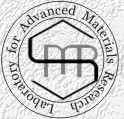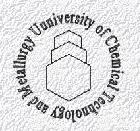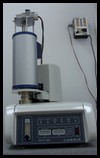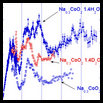1. Synthesis
Technologies for development of coatings and samples with different compositions in dependence of the end-user needs. (Synthesis from liquid (including sol- gel route) and solid state).
2.Physical, chemical and thermo-dynamical analysis
Phase diagram interpretation for optimization of composition/s and the technological parameters of synthesis procedures. Thermodynamics tests of stability by TG-DSC, TG-DTA, and/or DTG measurements with phase diagrams correlations and phase stability interpretation, are available.
3.Structure characterization
High level of competence exists regarding application and interpretation of different methods: Spectroscopic, Diffraction and Thermodynamic tests, Phase analysis and control, Test Morphology, Surface Composition control and Other structure characterization tests, including Nuclear methods as: Neutron diffraction, Fe57 Moessbauer spectroscopy, positron annihilation and more accessible methods as: X-ray diffraction, X-ray fluorescent spectroscopy analysis, IR spectroscopy, X-ray photoelectron spectroscopy, SEM, TEM, EDX, AFM and etc. )
4.Properties investigations
Listing of selected standards (glass, ceramic, metals and alloys, polymers) actual for the progress of a respective project and useful for the end- user application are available. Potential for measurements of thickness, density, thermo mechanical properties and etc. exists.
5. Performance characteristics
5.1. Corrosion study via Application of Potenciodynamic method
The tests can be performed in different conditions in dependence of the characteristics of the test samples (substrate and coatings/films) e.g. influence of the media parameters.
As a consequence of the above measurements
can be defined as follows:
- Corrosion potential
- Density of corrosion current
- Break- down potential
- Corrosion mechanism and kinetics determination
- EP method of corrosion
- Stationary polarization (anodic or cathodic kind
of polarization).
- EIS measurements in dependence of Temperature,
Frequency (FRA analysis) and other parameters.
- Electrochemical noise measurements.
5.2. Atmosphere corrosion tests procedures
a) Test under cold atmosphere conditions
b) Test under dry heat treatment
c) Test under vibrations (sinusoidal/s - curve vibrations)
d) Test under salty mist
e) Test under low atmosphere pressure
f) Test on hit treatment
g) Test under high humidity level and/or
h) Test of the impact of the sun radiation
5.3. Corrosion tests and aging phenomena at special conditions and atmosphere (high temperature corrosion tests)
The tests can be performed in different conditions described in short below, in dependence of the characteristics of the test samples (substrate and coatings/films) and the end user requirements. The tests are useful for materials and elements for energy application e.g. SOFC - solid electrolyte fuel cells
6. Evaluation procedure for pre- industrial applications if available













